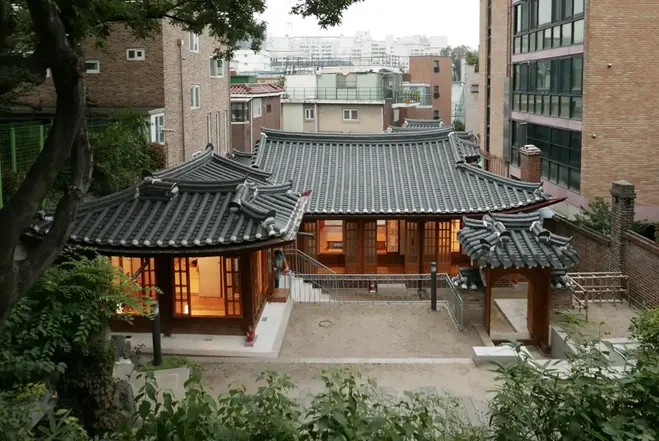





Seochon: Explorative Walk / Whitespace. Walking along a historical neighborhood with a local
Tour description
Seoul is a fascinating city, which use to be the capital for more than 600 years, has a lot of interesting history and different stories behind it.
Since it has been the capital for so long there are old towns which has been here for few centuries.
Seochon is one of the old towns with a lot of historical background.
If you are interested, let's find out together!
_____________________________________________
Whitespace
Hong Geon-ik House presents the
‘Whitespace’ route of the Seochon walking tour.
In Seochon, where the intricate tapestry of contexts often leaves little room for unoccupied spaces, this route uncovers hidden nooks such as small courtyards, gardens, and parks—spaces that are often overlooked.
Starting at the Hong Geon-ik House, we invite you to explore these often-overlooked public courtyards and learn about their cultural and communal significance, gaining a deeper understanding of the neighborhood.
_____________________________________________
Main spots to visit:
📍Seochon Village(one of the old towns in Seoul):
One of the old towns started from Joseon Dynasty. A popular neighborhood for locals to hangout with restaurants, museums, galleries, cafes, and small shops.
💡 We will be visiting different spots from this area
📍Seochon Lounge:
This modernized hanok, remodeled into a two-story structure, is currently designated as a Seoul Public Hanok and open to all citizens. The first floor, including an outdoor courtyard, is dedicated to exhibitions that showcase the value and charm of Korea's traditional housing culture. The second floor is designed as a relaxing reading area, equipped with books that explore hanok and traditional residential culture.
📍Sangchonjae:
Sangchonjae, a traditional hanok cultural space, was transformed from a long-abandoned hanok
formerly owned by the police department. It was purchased and restored by the Jongno District in 2013
and opened to the public in 2017. Named after
'Sangchon'(meaning 'upper village'), which was the historical name for Sejong Village located west of Gyeongbokgung Palace, Sangchonjae showcases
traditional hanok architecture from the late 19th century. It features an ondol system and hosts exhibitions related to this traditional heating technology. Additionally, it offers a variety of traditional cultural programs, including hanbok experiences, crafts, and seasonal festivals.
📍Site of Lacebark Pine of Tongui-dong:
Once home to a 600-year-old Lacebark Pine (white pine) standing 16 meters tall with a girth of over 5 meters, this site housed Korea’s largest and most beautiful white pine tree. Designated Natural Monument No. 4 in 1962, the tree was tragically lost to a typhoon in 1990, leaving only its stump.
Residents have since planted and nurtured new Lacebark Pine trees nearby, and today, three healthy white pines grow alongside the remains of the original.
📍Tongui-dong Village Square:
This public park was originally a private property purchased by the Seoul city in 1986 and converted into a park in 1996. After being sold to private hands in 2016, a passionate campaign by local residents led the city to repurchase and restore it. Now, Tongui-dong Village Square serves as a communal space for relaxation and hosts various cultural events and programs.
📍Cheongwadae Sarangchae Fountain Square:
Originally the official residence of the Chief Presidential Secretary, this site became the Hyoja-dong Sarangbang in 1996, and was transformed again in January 2010 into the current Sarangchae. Touted as “a sanctuary open to all,” Sarangchae now serves as both a cultural hub and exhibition space. Its front courtyard is open for public use, hosting cultural and artistic performances, while the fountain square
aligns seamlessly with the Yeongbin-gwan (State Guest House) and Bukaksan Mountain, offering citizens and visitors a welcoming place to relax and enjoy.
📍Mugunghwa Park:
Originally part of the Korean Central Intelligence Agency’ s safehouse grounds in Gungjeong-dong, this site was off-limits until the Cheongwadae road was opened in 1993. It was then developed into a public rest area. Designed in the shape of the Taeguk pattern, the park prominently features mugunghwa (Korea’s national flower) and a fountain formed as the character j eon g (井, meaning “well”), symbolizing Gungjeong-dong. Along with 7,700 wildflowers, the park is home to some 1,500 trees representing 13 different species, including pines and zelkova, offering visitors a tranquil retreat.
📍Suseongdong Valley:
Situated at the border between Nusang-dong and Ogin-dong, Suseongdong Valley is renowned for its loud, clear water sounds, which is why it was historically known as Suseong-dong (“Village of Water Sounds”) during the Joseon Dynasty. This area also served as a cultural hub in the 18th and 19th centuries, where middle-class intellectuals gathered to foster the flourishing of Wehang literature. While
the construction of the Ogin Apartments in the 1970s initially marred its scenic beauty, the apartments were demolished in 2010, restoring the valley’s former appearance. Today, it is designated and preserved as a Seoul Monument
Host : Seoul Metropolitan Government
Organizer : OPENHOUSE
Planning : OPENHOUSE
Tour Run by: Yang Daeun (+Dani)
photo © Hong Geon-ik House. All rights reserved
*Some places might not be able to go in. In this case, it’s going to be an outside visit.
_____________________________________________
❕❗️Even the time slot you want is full, let me know when you want to join, and I’ll try my best to make a spot for you😄
What will we see on this tour?




